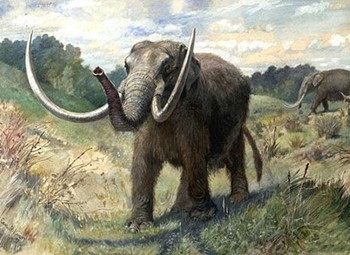
But despite their name, the mighty Everglades did not exist during the ice age. So what did pre-historic Florida look like? There is one place in northern Florida that has revealed more ice age secrets than almost anywhere else, the dark slow-moving waters of the Aucilla River. Here ideal conditions for fossilization created a hidden store of ice age evidence. Unlike in the crystal clear spring waters, these clues were never unveiled for all to see. But the Aucilla has now been studied intensively for more than 20 years.
盡管它的名字叫做“大沼澤地”,但是這片沼澤在冰河時代并不存在。那史前的佛羅里達到底什么模樣?在佛羅里達北部的一個地區,我們能夠發現比其他地方更多的冰河時代的痕跡。這就是尤喜拉河,在這里,幽暗的河水緩慢地流淌著。這里的環境極其適合化石的保存,因此這里儲存著很多冰河時代的痕跡。和晶瑩透亮的溫泉不同,這些線索不會在眾人面前一顯真容。但如今尤喜拉河已經被人們深刻研究了20余年。
Along some stretches of the riverbed were massive bones recreated here, perfectly preserved for more than 13,000 years. One of the most significant discoveries was the huge skull of an American mastodon. Mastodons, close relatives of mammoths, were widespread all over North America during the ice age. They grew over three metres tall, the size of Africa elephants today. We know a lot about the mastodons, especially their diet, thanks to the preserved dung they left behind.
河床的沿岸能夠發現很多巨大的骨骼化石,他們被完好地保存了13000多年。其中,最具標志性意義的發現之一就是一個巨大的美洲乳齒象頭骨。乳齒象是猛犸象的近親,在冰河時代,他們的足跡遍布整個北美。他們的身高可達到3米,和現在的美洲大象體型相當。我們對乳齒象了解頗深,尤其是他們的飲食,這是因為他們留下的糞便保存良好。
英文文本來自普特英語,譯文屬可可原創,僅供學習交流使用,未經許可不得轉載。











